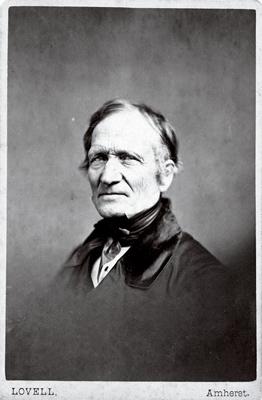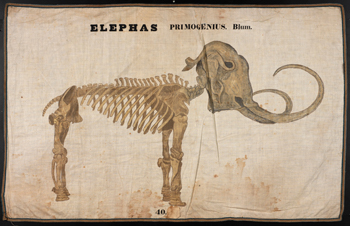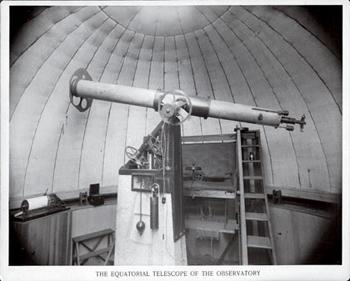
Edward Hitchcock
1825: Edward Hitchcock joins the faculty as Professor of Natural History & Chemistry.
1826: Amherst faculty propose a “parallel course” of instruction that emphasizes chemistry, physics, and mechanical sciences. Abandoned in 1829.
1827: Johnson Chapel completed. Includes a room for scientific apparatus, a laboratory, and a separate cabinet for the college’s mineral collections.
1830: Edward Hitchcock is appointed State Geologist for Massachusetts.
1831: Professor of Mathematics and Natural Philosophy Sylvester Hovey travels to London and Paris where he spends $8,000 on books, “chemical apparatus” and astronomical equipment for the college.
1835: Edward Hitchcock Sr. establishes the Hitchcock Ichnological Cabinet. Today it is one of the largest dinosaur-footprint collections in the world.

Illustration by Orra White Hitchcock
1825-1863: Orra White Hitchcock, one of America’s first female scientific illustrators, creates scientific renderings for use in Amherst College classes and lectures.
1836: Edward Hitchcock is appointed Geologist of the First District of New York State.
1848: The Octagon is completed, originally built to house the natural history collection and astronomical apparatus. In 1855 a geology lecture room is added to the building.
1852: Trustees established Scientific Department. William S. Clark (AC 1848) joins faculty as Professor of Chemistry (1852-1867).

The equatorial telescope of 1854
1854: The equatorial telescope is added to the Octagon to establish the Lawrence Observatory.
1855: Appleton Cabinet built to house the expanding natural history collection.
1857: Williston Hall is built to house the department of Chemistry. Chemistry laboratory moved from Johnson Chapel to Williston. Edward Hitchcock appointed Vermont State Geologist.
1858: Edward Hitchcock publishes The Ichnology of New England: A Report On The Sandstone Of The Connecticut Valley, Especially Its Fossil Footmarks, Made To The Government Of The Commonwealth Of Massachusetts.
1862: Professor William Cole Esty (AC 1860) begins work as a Mathematics instructor; is Professor of Mathematics & Astronomy until his retirement in 1905.
1867: William S. Clark leaves Amherst to serve as President of the Massachusetts Agricultural College, now known as UMass Amherst.
1870: Walker Hall is constructed. Referred to as the “Temple of Science” the building housed science departments as well as the President’s Office. It was damaged by fire in 1882, rebuilt, then razed in the 1960s to make way for the Robert Frost Library.
1871: From the 1870-71 Catalogue: “The collections, as arranged in all these cabinets, contain more than 100,000 specimens of the animal, mineral, and vegetable kingdom.”
1876: William S. Clark (AC 1848) invited to establish a modern agricultural school in Japan: Sapporo Agricultural College (now Hokkaido University).
1877: Lucien Ira Blake graduates from Amherst; later invents telegraph system used by early submarines.
1881: David Todd (AC 1875) begins work as Instructor of Astronomy; holds the post of Professor of Astronomy & Navigation 1892-1920.
1884-85: For the first time the college catalog divides the courses of study into academic departments, including the Departments of Mathematics, Physics, Astronomy, Chemistry, Mineralogy & Geology, Biology, and Hygiene & Physical Education.
1887: David Todd travels to Japan with the American expedition to observe the solar eclipse, one of many international expeditions he made for astronomical observations.
1894: Fayerweather Hall is built to house chemistry and physics classes.
1897: Gilbert Grosvenor graduates from Amherst; is editor of National Geographic from 1899-1954.
1900: Frederick B. Loomis (AC 1896) joins the faculty as a Biology Professor.
1903: Wilder Observatory completed under the direction of Professor David Todd.
1909: Biology-Geology Building completed; renamed Webster Hall in 1972.
1911: Bachelor of Science degree is discontinued; Professor Loomis leads a seven-month expedition of Amherst students to Patagonia in search of fossils (June 1911-January 1912).
1918: Professor Loomis moves from Biology Department to Geology Department.
1923: Professor Loomis leads an expedition to Florida to excavate recently discovered fossil bones.
1925: Professor Loomis returns to Florida to complete the excavation of the Columbian Mammoth skeleton that is now on display in the Beneski Museum. Amherst’s mammoth is the fifth largest specimen known to exist.

Moore Laboratory
1929: Moore Laboratory of Chemistry is built. Converted to student housing in 1976.
1936: Professor Loomis leads his last expedition, taking Amherst undergraduates on the Rainbow Bridge-Monument Valley Expedition in Arizona and Utah. Loomis dies in 1937.
1940: Dr. Charles Drew (AC 1926) appointed Medical Director of the US Blood for Britain project; introduces bloodmobiles and many improvements in storage and handling of blood supplies.
1942: Department of Geology is moved to renovated Pratt Museum, the former Gymnasium.
1948: Phillip T. Ives (AC 1938) Weather Station is established.
1961: Dedication of Bassett Planetarium in Morgan Hall; gift of Preston R. Bassett (AC 1913).
1967: Arthur Vining Davis Foundation gave $1,000,000 for a new Science Center. Merrill Science Center opens in 1968.
1972: Biology Building addition; renamed Webster Biology Building.
1973: Amherst establishes the nation's first undergraduate neuroscience program.
1984: Seeley Mudd is built to house mathematics and computer science.
1989: Harold Varmus ’61 is awarded the Nobel Prize in medicine.
1990: Henry W. Kendall ’50 awarded Nobel Prize in physics jointly with two others.
1996: The new life sciences building is completed and the adjoining Merrill Science Center undergoes renovation.
1998: The Quantitative Center for informal tutorial service is established; Webster Biology renamed Webster Hall.
2004: Life Sciences Building dedicated as McGuire Life Sciences Building.
2006: The new Beneski Earth Sciences Building and Museum of Natural History opens. It houses Amherst’s vast and significant natural history collections, formerly held at the Pratt Museum.
2007: The faculty endorses a new major in environmental studies.
2010: The faculty endorses the creation of the Program in Biochemistry and Biophysics.
2017: Jeffrey C. Hall ’67 is awarded the Nobel Prize in Physiology or Medicine jointly with two others.
2018: The New Science Center is completed.